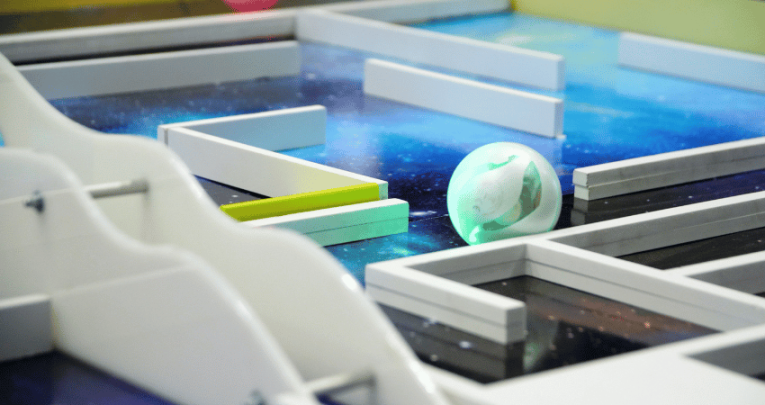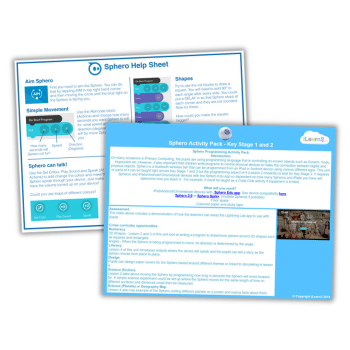Sphero – How to use this coding robot in your classroom

Laura Di Pasquale explores different ways to use Sphero coding robots in the classroom…

The concept of coding is often considered the empire of geeks and technology gods. But let’s face it, in the current climate we live in, we’re all going to need to speak a bit of robot lingo. This is where Sphero BOLT+ – a fun, versatile little robot – rolls in.
Integrating Spheros into your lessons can make abstract concepts concrete and learning incredibly fun. WARNING: teachers become rather competitive with Spheros and will also enjoy playing the toilet flushing sound effects, racing one another and crashing them together.
It’s best to do your training in a private room, away from the prying eyes of little children.
Start with unplugged activities
Starting with coding can be daunting. The fear of the unknown, coupled with concerns about technical glitches, can be daunting.
But fear not! You don’t need to be a coding whizz to teach it. Websites like code.org offer free resources and tutorials that can guide you and your pupils through the basics.
Introduce unplugged activities first. These are coding exercises that don’t require a computer, making them perfect for easing into the subject.
For instance, have pupils write ‘programs’ for each other to follow, like making a jam sandwich or how to pick up a pencil from the ground.
Once they grasp the basics, move to visual programming languages like Scratch, which allows kids to create programs by snapping together blocks of code.
To truly inspire children, it’s essential to show them how coding is used in the real world. After all, it’s not just about making pixelated cats dance on a screen (although that’s pretty cool, too).
From self-driving cars to smart home devices that can remind you where you left your keys, coding and robotics are at the heart of technological advancements.
Highlighting these examples can spark curiosity, make coding feel like magic, and motivate children to dive deeper into their coding journey.
Cross-curricular applications
Sphero robots aren’t just for coding class – they can bring excitement to any subject.
One of the greatest strengths of a Sphero is its ability to turn learning into play. By gamifying lessons, we ensure children remain engaged, excited, and maybe even convinced that school is actually fun.
Instead of just staring blankly at a textbook, they’re navigating a robot through a maze or racing their Sphero in a high-stakes classroom Grand Prix.
Trending
Imagine a world where maths class involves programming a Sphero to follow a path shaped like a giant pizza slice. Who knew geometry could make you this hungry?
Or picture history lessons where pupils recreate the path of ancient explorers using a Sphero, all while trying to avoid the ‘pitfalls’ (aka strategically placed LEGO bricks) of history.
In science, pupils can program a Sphero to simulate the orbit of planets, ensuring no one ever forgets that Pluto still has feelings…
Your Sphero will come with full instructions and plenty of online resources to help you guide your class to coding successes like these. Once you’re confident with your Sphero device, try the following activities:
Maths
Program your Sphero to follow specific geometric patterns or solve maths problems. Have pupils calculate the distance a Sphero travels given different speeds and times.
You can simply have a series of numbers on the floor, ask the pupils a question and they have to drive their Sphero to the correct answer.
Science
Use your Sphero to test and simulate the effects of different forces and motion. Can you build a ramp and calculate what speed and angle is required to enable your Sphero to climb the ramp and jump off the other end? (They’re pretty sturdy!)
Art
Attach a marker to your Sphero and program it to create abstract art. You might discover the next Jackson Pollock, or it could end up like Edvard Munch’s ‘Angry Dog’ portrait.
History
Recreate historical events by programming your Sphero to ‘act out’ scenes. Imagine a mini Battle of Stalingrad rolling across your classroom with epic sound effects (including screaming, explosions and whistles blowing).
English
Have pupils write stories featuring a Sphero as a character, then program the robots to act out parts of their tales.
You could simply have pictures from a famous story, such as Goldilocks and the Three Bears and ask the children to drive their Sphero from one image to another, whilst telling their story verbally.
Making the most of your Sphero
- Invest time in training. Many organisations offer workshops and online courses specifically designed for teachers to get comfortable with coding and robotics.
- Form a support group with other teachers. Sharing experiences, troubleshooting together, and celebrating successes can make the journey much more enjoyable.
- Identify pupils who show a keen interest in technology and empower them to assist their peers. These ‘tech leaders’ can be invaluable resources in the classroom.
- Integrate physical computing into your lessons gradually. Begin with simple projects and build complexity as confidence grows.
- Incorporate Spheros into storytelling by programming them to act out parts of a story. This can enhance literacy skills and bring narratives to life.
- Combine subjects like history and science by having children program Spheros to re-enact historical events or scientific discoveries.
- Organise coding challenges or competitions to motivate pupils and encourage friendly competition. This can be a great way to showcase student skills and creativity.
- Give your class time to play and experiment with Spheros outside of structured lessons. This free exploration can lead to innovative ideas and deeper understanding.
Laura Di Pasquale is a primary school teacher in Glasgow. She is an Apple learning coach and micro:bit champion. Download a Sphero robot programming activity pack for KS2.







